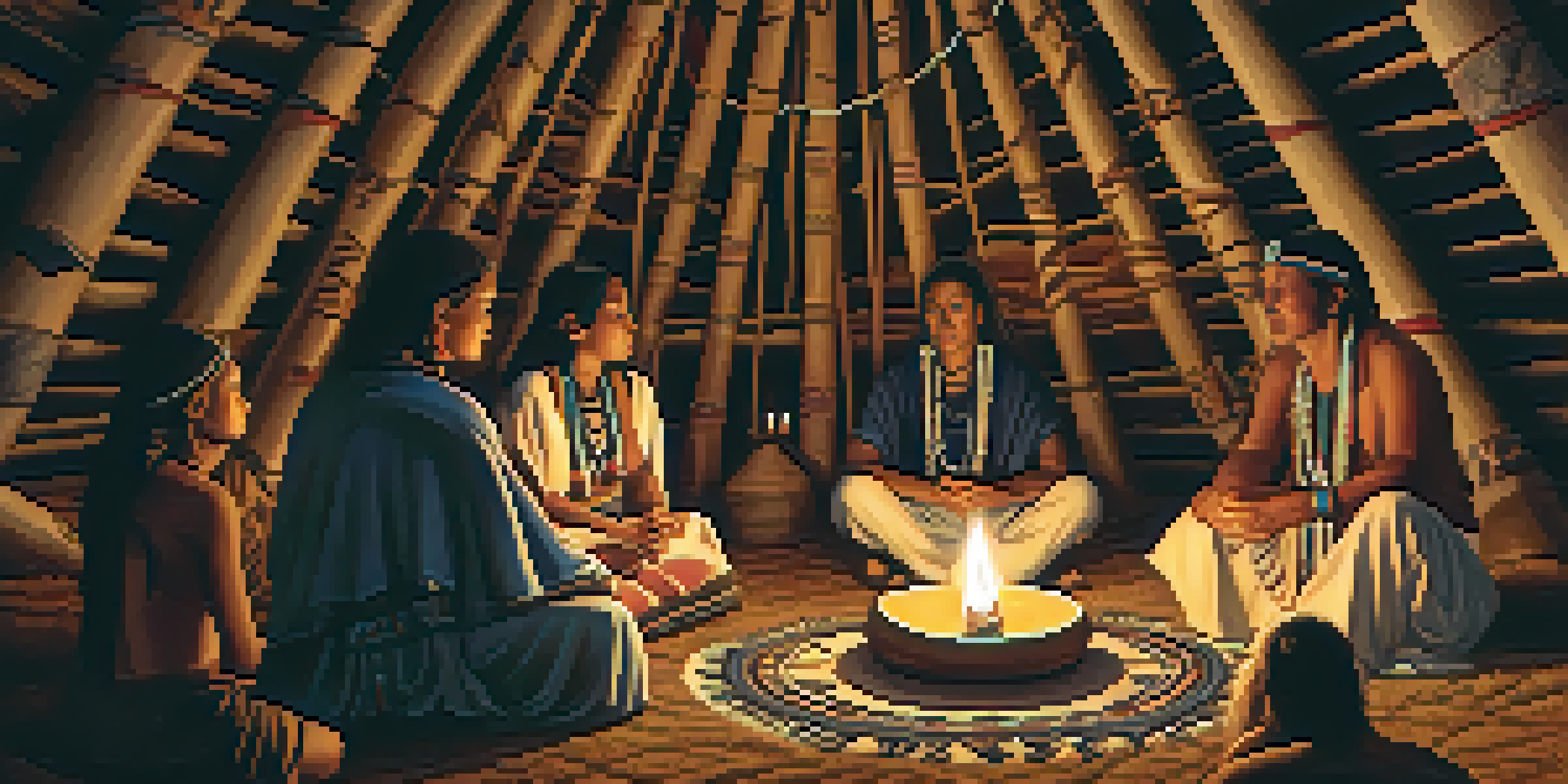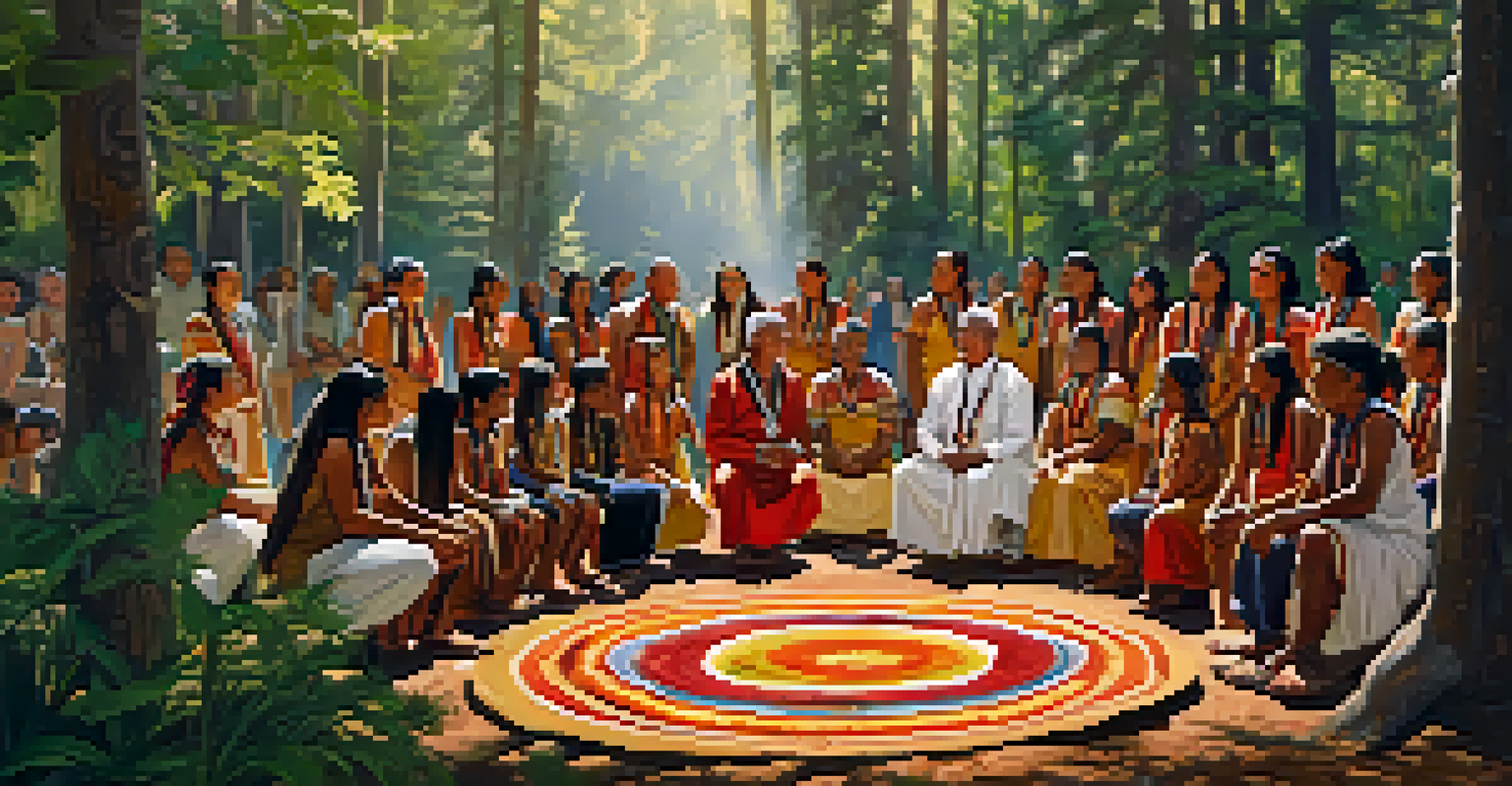Peyote Ceremonies: Healing Traditions among Indigenous Peoples

Understanding Peyote: A Sacred Plant in Indigenous Culture
Peyote, a small cactus native to the southwestern United States and Mexico, holds deep spiritual significance for various Indigenous peoples. Traditionally used in religious ceremonies, Peyote is known for its psychoactive properties, which can induce altered states of consciousness. For many tribes, such as the Huichol and Navajo, Peyote is more than just a plant; it’s a bridge to the spiritual world, facilitating communication with the divine.
The use of Peyote is a way to connect to the sacred and explore the depths of the self in a community of understanding.
The use of Peyote is often seen as a gift from the Creator, leading to profound insights and personal healing. It's not merely about the experience of consuming the cactus, but about the rituals and community that surround it. These gatherings are steeped in tradition, often involving songs, prayers, and storytelling that reinforce cultural identity and values.
As society continues to evolve, the understanding of Peyote's role in Indigenous healing practices is gaining wider recognition. Many people are now looking to these ceremonies not just for personal growth, but as a way to connect with deeper spiritual truths. This shift reflects a broader interest in holistic healing practices and respect for Indigenous knowledge.
The Structure of a Peyote Ceremony: What to Expect
A typical Peyote ceremony lasts all night, often beginning at sunset and concluding at dawn. Participants gather in a sacred space, usually a tipi or other ceremonial structure, where the heart of the ceremony unfolds. The space is carefully prepared, creating an atmosphere of reverence and connection, essential for the spiritual experience to take place.

The ceremony is led by a knowledgeable leader, known as a roadman, who guides participants through the rituals. The roadman serves as a facilitator, ensuring that the ceremony flows smoothly and that everyone feels safe and supported. This leadership is crucial, as it helps to maintain the sacredness of the experience and encourages participants to engage deeply with their inner selves.
Peyote's Spiritual Significance
Peyote serves as a sacred bridge for Indigenous peoples, facilitating deep spiritual connections and healing within their cultural traditions.
During the ceremony, participants consume Peyote in its various forms, often accompanied by prayer and song. This communal aspect fosters a sense of unity and shared purpose, allowing individuals to explore their spirituality while being supported by the group. The experience can lead to profound revelations, emotional healing, and a renewed sense of connection to both oneself and the larger universe.
Healing Through Peyote: Mind, Body, and Spirit
The healing potential of Peyote ceremonies is multifaceted, addressing physical, emotional, and spiritual dimensions. Many participants report transformative experiences that help them confront past traumas, alleviate anxiety, and foster personal growth. This holistic approach to healing aligns with the Indigenous understanding that mind, body, and spirit are interconnected.
Peyote serves as a bridge between the physical and spiritual realms, allowing us to explore our deepest truths.
Moreover, the ceremony provides a safe space for individuals to explore their feelings and gain insights into their lives. Participants often describe a sense of clarity and perspective, helping them make sense of their challenges. This ability to reflect and gain new understanding is a vital aspect of the healing process.
In many ways, Peyote serves as a catalyst for change, prompting individuals to let go of burdens they’ve carried for years. By addressing these issues in a supportive environment, participants can emerge with renewed strength and a clearer path forward. This process illustrates the powerful role of cultural traditions in fostering resilience and well-being.
Cultural Significance: Peyote Beyond Healing
Beyond its healing properties, Peyote holds immense cultural significance for many Indigenous communities. It acts as a symbol of resilience, representing the enduring spirit of these cultures despite historical challenges. The ceremonies are not only a form of healing but also a celebration of identity, community, and continuity.
For many tribes, the act of gathering for a Peyote ceremony reinforces social bonds and cultural heritage. It provides an opportunity for storytelling, where elders share wisdom and teachings passed down through generations. This intergenerational exchange strengthens community ties and ensures the survival of cultural practices.
Challenges Facing Peyote Practices
Legal restrictions and concerns about cultural appropriation pose significant challenges for Indigenous communities in practicing Peyote ceremonies.
Moreover, Peyote ceremonies often serve as a response to contemporary issues faced by Indigenous peoples. By fostering spiritual growth and healing, these traditions empower individuals and communities to navigate modern challenges while maintaining their cultural identity. This dual role underscores the importance of Peyote in both personal and communal contexts.
Legal and Social Challenges Facing Peyote Use
Despite its deep-rooted significance, the use of Peyote faces numerous legal and social challenges. In many places, the legal status of Peyote is complicated, often restricted due to its psychoactive properties. This creates a tension between Indigenous practices and contemporary laws, raising questions about cultural rights and self-determination.
Additionally, as interest in Peyote grows outside Indigenous communities, concerns about cultural appropriation arise. Many Indigenous leaders emphasize the importance of participating in Peyote ceremonies as part of a community with a historical connection to the practice. They advocate for respect and understanding of the traditions, urging outsiders to recognize the sacredness of these rituals.
Advocacy for the protection of Peyote and its cultural significance is ongoing. Many Indigenous groups are fighting for their rights to practice these traditions freely, aiming to educate others about the importance of Peyote in their cultures. This struggle highlights the broader issue of Indigenous rights and the need for societal recognition and respect.
Modern Adaptations of Peyote Ceremonies
As society evolves, so too do the practices surrounding Peyote ceremonies. Some communities have begun to adapt traditional rituals to fit contemporary contexts, allowing for broader participation while maintaining the core values of the ceremonies. This adaptation can take various forms, such as incorporating new healing practices or blending traditional elements with modern approaches.
These modern adaptations have opened the door for more people to experience the transformative power of Peyote, fostering greater understanding and respect for Indigenous traditions. Workshops and educational events are increasingly organized, where individuals can learn about the significance of Peyote and its role in healing. This sharing of knowledge helps bridge cultural gaps and promotes mutual respect.
Modern Adaptations and Education
Contemporary adaptations of Peyote ceremonies are emerging, allowing broader participation while striving to preserve the core values of these sacred practices.
However, these adaptations come with their own challenges, such as ensuring that the essence of the tradition is preserved. Many Indigenous leaders stress the importance of maintaining authenticity and honoring the sacred nature of the ceremonies. This balance between tradition and modernity is essential for the continued relevance of Peyote practices in today's world.
The Future of Peyote Ceremonies: Hope and Resilience
Looking ahead, the future of Peyote ceremonies appears to be a mixture of hope and resilience. As awareness grows about the importance of these traditions, there is potential for greater acceptance and understanding within wider society. This shift could lead to more supportive environments for Indigenous peoples to practice their cultural rituals freely.
Furthermore, ongoing advocacy efforts aim to protect the rights of Indigenous communities to use Peyote. These initiatives are crucial in ensuring that future generations can continue to engage with their cultural heritage. By promoting understanding and respect, society can play a role in preserving these sacred traditions.

Ultimately, Peyote ceremonies represent the enduring strength of Indigenous cultures. They are a testament to the resilience of communities that have maintained their traditions despite historical adversity. As we move forward, fostering respect and understanding for these practices will be key in nurturing a more inclusive and compassionate society.